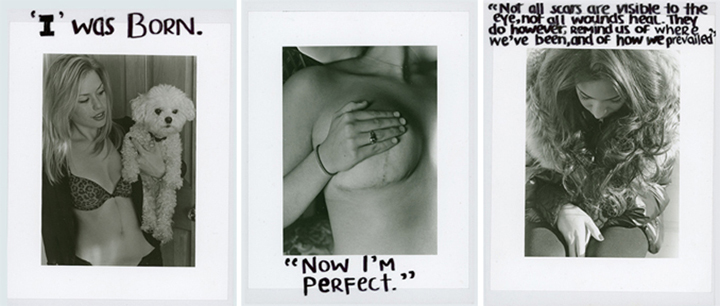

Stephanie Mungiovi
2nd Year, Art Education Major
Scars: They Will Always Remain a Part of You
This photographic series explores how scars reflect our identities. A physical scar becomes a visible trait, while an emotional scar may affect our feelings and actions. Whether a physical scar is obtained at birth or later in life, we live with it and see it everyday.
Whether scars are emotional or physical, they are embedded within each of us. Collected over time, these various marks, blemishes, and imperfections hold stories that are powerful and inescapable. The memories scars provoke become part of who we are and influence how we perceive ourselves.
Like many people, I carry both physical and emotion scars. Physically, my scars are limited to marks resulted from the chicken pox, which is not as painful as my emotional scars caused by ever-changing relationships, heartbreaks and personal failure. How these types of scars that have affected my identity has inspired my project entitled Scars. The project explores people’s relationship to scars. Scars is also inspired by Montreal artist Nadia Myre’s Scar project from 2005.
I was first introduced to Myre’s work in a Cegep class , when she was invited as a guest lecturer and to lead an art making activity. Using scissors, thread and needles, we sewed our own versions of ‘scars’ onto canvas material. We were then invited to write about the narrative and concept for our representation of a physical, emotional, psychological or spiritual scar. The students’ final artworks were included as part of Nadia Myre’s ongoing Scars project.
Myre initiated this ongoing project as an open lab experience, conducting workshops with youth groups, cultural centres, seniors centres, prison circles and schools. The Scars project has been exhibited in galleries and museums in Canada and the United States (Myre, 2011). As her website states:
Myre sees this work as slow research, and describes it as a grassroots study of how people describe their wounds, both literal and metaphorical, as well as a study in symbology. However The Scar project is more than her iconographic findings and symbolical distillations. As a vehicle for people to anonymously share their personal narratives and traumas with others, the project creates a space that is simultaneously contemplative and transformative.
Participating in Myre’s large scale community-based project influenced my art practice. I was inspired by the types of reflections the project provoked, becoming increasingly intrigued by the stories behind people’s physical, emotional, psychological and spiritual scars. This interest inspired a series of work that addresses the question how to visually communicate emotional and invisible scars through photography.
The individuals photographed for this series are women who play an important role in my life. Included are those who have supported me during difficult times as well as those to whom I have offered support. Although many women came forward with fascinating scars and stories, I felt the most powerful scars were those shared with me at an intimate level. Through writing, these women were asked to consider a thought-provoking sentence that connected them to their scar without revealing too much personal information. These sentences are written on the glass of the picture frame, over their photograph.

This series explores how scars reflect our identities. A physical scar becomes a visible trait, while an emotional scar may affect our feelings and actions. Whether a physical scar is obtained at birth or later in life, we live with it and see it everyday. Emotional scars may play an influential role in the way we carry ourselves and the choices we make in our daily life.
This series also explores how a scar is a representation of memory. Each scar is connected to a time, place and perhaps a person, which may be associated to a specific memory.
By observing my own choice of concepts and processes for this series as well as other artworks, I realize that I often reflect my emotional scars through visual work, using heartbreak and loss as inspiration. This project has also made me realize that reflection is an important quality from an artist-teacher perspective.

As author Alan Thornton points out, the artist-teacher, is a person who both makes and teaches art (2005, p. 167). As an artist-teacher, I not only make art, but reflect on the art making process to be a better teacher. Thornton argues that as artist-teachers, we are responsible for appropriating teaching strategies which supports convictions, knowledge and art skills to effectively convey concepts (p.169).
To conclude, I believe it is through a reflective art practice that complex emotions and ideas can be communicated through art. Although I acknowledge it can be a difficult process to deal with the theme of personal scars, I believe artistic inquiry can provide a meaningful experience for the artist, participants and viewers alike.
References
Myre, N. (2011). Scar project. Retrieved from www.nadiamyre.com.
Thornton, A. (2005). The artist teacher as reflective practitioner. International Journal of Art & Design Education, 24(2), p. 166-174.